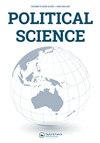Gender Gap in US Public Opinion
IF 1.2
4区 社会学
Q3 POLITICAL SCIENCE
引用次数: 0
Abstract
In a representative democracy, policymakers, elected officials, and bureaucrats should heed public opinion. Research to date provides evidence that policymakers do care about the public’s positions on policy and that presidential administrations often seek public approval of their legislative agenda (see the Oxford Bibliographies in Political Science article, “Policy Responsiveness to Public Opinion” by Robert S. Erikson. Therefore, it is valuable to understand consistent and significant influences on the public’s policy positions and political attitudes. Gender appears to be a consistent and often significant influence on opinion. Generally, women tend to be more likely than men to adopt liberal positions on a long list of policies, including force issues, the size of the welfare state, the environment, and equal rights. For certain issues, gender seems to have a more complicated, or more conservative, influence, such as on abortion and on the legalization of marijuana. Overall, gender matters when considering public opinion in the United States. Moreover, issue gaps partially account for the gender gap in party identification and vote choice where women are more likely than men to identify as Democrats and vote for Democratic candidates. For example, in electoral simulations when women are given the same policy positions as men, a considerable reduction in the voting gender gap occurs. Readers interested in how gender influences political behavior should consult the Oxford Bibliographies in Political Science article, “Gender, Behavior, and Representation” by Elisabeth Gidengil. With women being slightly more than half of the population and being more likely to vote than men in recent elections, gender differences in policy preferences have substantial political consequences. This article discusses research on several issue areas with established gender gaps in opinion and provides a brief overview of scholarship investigating the origins of gender differences in public opinion. Much of the research cited here focuses on gender differences in public opinion but some material controls only for gender and finds a significant relationship.美国民意中的性别差异
在代议制民主中,决策者、民选官员和官僚应该听取公众意见。迄今为止的研究表明,政策制定者确实关心公众对政策的立场,总统政府经常寻求公众对其立法议程的批准(见《牛津政治学参考书目》Robert s。埃里克森。因此,了解对公众政策立场和政治态度的持续和重大影响是有价值的。性别似乎对舆论产生了一贯的、往往是重大的影响。一般来说,在一长串政策中,女性往往比男性更有可能采取自由主义立场,包括武力问题、福利国家的规模、环境和平等权利。对于某些问题,性别似乎有更复杂或更保守的影响,比如堕胎和大麻合法化。总的来说,在考虑美国的公众舆论时,性别很重要。此外,问题差距在一定程度上解释了政党认同和选票选择方面的性别差距,女性比男性更有可能认同民主党并投票给民主党候选人。例如,在选举模拟中,当女性被赋予与男性相同的政策职位时,投票性别差距会显著缩小。对性别如何影响政治行为感兴趣的读者应该查阅伊丽莎白·吉登吉尔的《牛津政治学参考书目》文章《性别、行为和代表》。由于女性略高于人口的一半,在最近的选举中比男性更有可能投票,政策偏好的性别差异产生了重大的政治后果。本文讨论了对几个已经存在性别意见差距的问题领域的研究,并简要概述了调查公众意见中性别差异起源的学术研究。这里引用的大部分研究都集中在公众舆论中的性别差异上,但一些物质控制只针对性别,并发现了一种重要的关系。
本文章由计算机程序翻译,如有差异,请以英文原文为准。
求助全文
约1分钟内获得全文
求助全文
来源期刊

Political Science
POLITICAL SCIENCE-
CiteScore
0.90
自引率
0.00%
发文量
13
期刊介绍:
Political Science publishes high quality original scholarly works in the broad field of political science. Submission of articles with a regional focus on New Zealand and the Asia-Pacific is particularly encouraged, but content is not limited to this focus. Contributions are invited from across the political science discipline, including from the fields of international relations, comparative politics, political theory and public administration. Proposals for collections of articles on a common theme or debate to be published as special issues are welcome, as well as individual submissions.
 求助内容:
求助内容: 应助结果提醒方式:
应助结果提醒方式:


